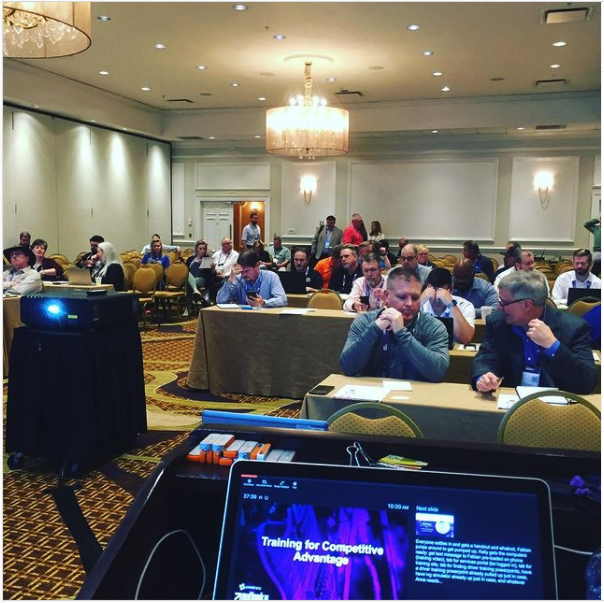The Omnitracs User Conference convened hundreds of fleet management, transportation, and logistics professionals in several cities to explore emerging trends, discover innovative technologies, and network with industry leaders. Attendees benefited from a comprehensive five-day program tailored specifically for trucking industry professionals.
The conference featured renowned transportation experts who led thought-provoking breakout sessions on key industry topics, including:
- The biggest trends affecting trucking and distribution today — and planning for the future
- An overview of the Omnitracs product roadmap
- Q&A with customers on overcoming operational challenges
- Hands-on training with Omnitracs solutions to maximize team effectiveness
- Insight into the future of ELD (Electronic Logging Device) compliance from regulatory and management experts and steps to remain successful with the US and Canadian Mandate
Fabian's Training Session mentioned in the press: Trucknews.com
Setting the Training Design Paradigm
There were four major componants to designing the user experience for our learners at the conference:
Audience Analysis
 Upon assuming responsibility for the conference training content and design, my initial priority was to analyze attendee demographics and roles to inform content development. This persona-based approach enabled more targeted content delivery than a focus on specific customer needs.
Upon assuming responsibility for the conference training content and design, my initial priority was to analyze attendee demographics and roles to inform content development. This persona-based approach enabled more targeted content delivery than a focus on specific customer needs.
My initial two-week plan included:
- Analyzing attendance data to identify and define three primary attendee personas.
- Consulting with key company leaders to understand customer needs.
- Conducting interviews with a representative sample of customers to gather feedback on previous events.
Personas
Analysis revealed three primary attendee personas: C-Suite/Executive (10%), Directors/VPs (20%), and Managers/Users (70%).
The C-Suite/Executive attendees primarily focused on networking, relationship building with Customer Success Managers and peers, and overall engagement. Content for this group required a high-level, engaging format to maximize their time investment.
Director/VP attendees also required high-level content, but with a focus on demonstrating the impact and ROI of their software investment. This insight became a key component of our show floor strategy and kiosk engagement with Product Managers. I implemented a system where training content presented in sessions was reinforced and demonstrated on the show floor.
Managers/Users comprised the largest segment (70%) and provided the most feedback. Their primary objectives were learning new features, gaining best practices, networking, and addressing company-specific challenges. The training track was critical for this audience, and sessions were designed to be highly informative and hands-on. This group also benefited most significantly from the introduction of the Smartbar.
Content Theme and Direction
 The Omnitracs User Conference convened hundreds of fleet management, transportation, and logistics professionals in several cities to explore emerging trends, discover innovative technologies, and network with industry leaders. Our sales, customer success, and support teams played a key role in providing valuable insights and information. Through extensive interviews and feedback gathering, we identified recurring themes that shaped the direction of our training content and design year after year. In close collaboration with marketing, we tailored our content to address the most impactful trends facing the market.
The Omnitracs User Conference convened hundreds of fleet management, transportation, and logistics professionals in several cities to explore emerging trends, discover innovative technologies, and network with industry leaders. Our sales, customer success, and support teams played a key role in providing valuable insights and information. Through extensive interviews and feedback gathering, we identified recurring themes that shaped the direction of our training content and design year after year. In close collaboration with marketing, we tailored our content to address the most impactful trends facing the market.
Careful thought was given to:
- Government mandates facing the industry
- Trends in the marketplace
- Competitive analysis and ROI
- Customer feedback
User Flow
 Through data analysis, I tracked customer attendance by day, session, and time slot, identifying peak engagement periods early in the morning and approximately one hour after lunch. This data-driven insight allowed us to strategically schedule high-impact content during these prime times. Furthermore, we investigated engagement strategies to improve attendance during less popular time slots.
Through data analysis, I tracked customer attendance by day, session, and time slot, identifying peak engagement periods early in the morning and approximately one hour after lunch. This data-driven insight allowed us to strategically schedule high-impact content during these prime times. Furthermore, we investigated engagement strategies to improve attendance during less popular time slots.
Over four years, we implemented the following:
- Giveaways (food, prizes, etc) to further engage the audience
- Hands-on learning labs
- Interactive Customer Panels
- Takeaways: Job aids, Handouts, thumbdrives with content
Recognizing the untapped potential of our support team, I championed the development and implementation of the "Smartbar" at the user conference following the second year. Initially relegated to a back room, I advocated for its relocation to the main show floor, progressively increasing its visibility each year. Ultimately, the Smartbar became a central hub, providing support, training, and documentation, significantly enhancing the customer experience.
Feedback and review
Feedback was a critical component of the design process, enabling evaluation of our implementations and adjustments to sessions and content.
Following the third user conference, I advocated for enhanced data collection within our surveys and metrics to facilitate strategic and targeted improvements. This included:
- In app surveys for each session
- Mandate for our speakers to encourage survey participation with prizes for most surveys answered
- Inclusion of showfloor engagement metrics, including smartbar engagement


